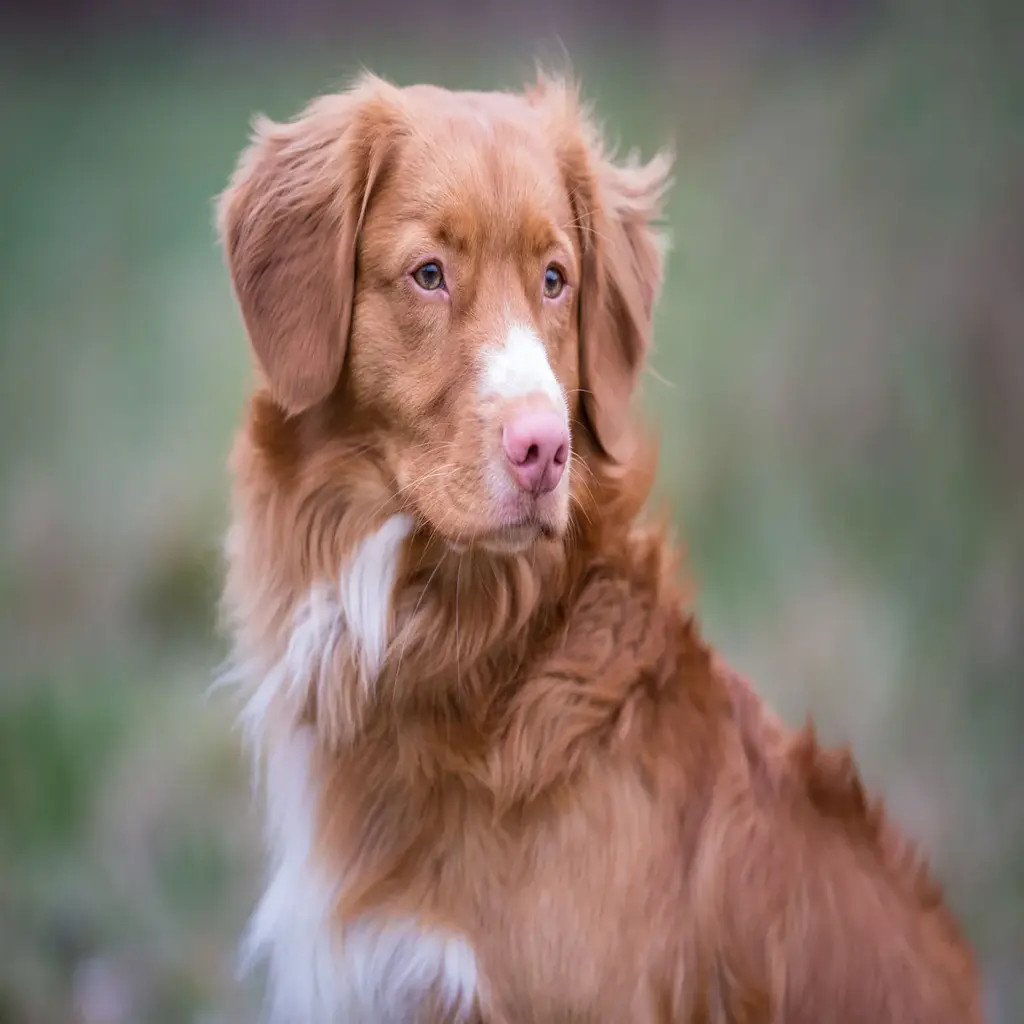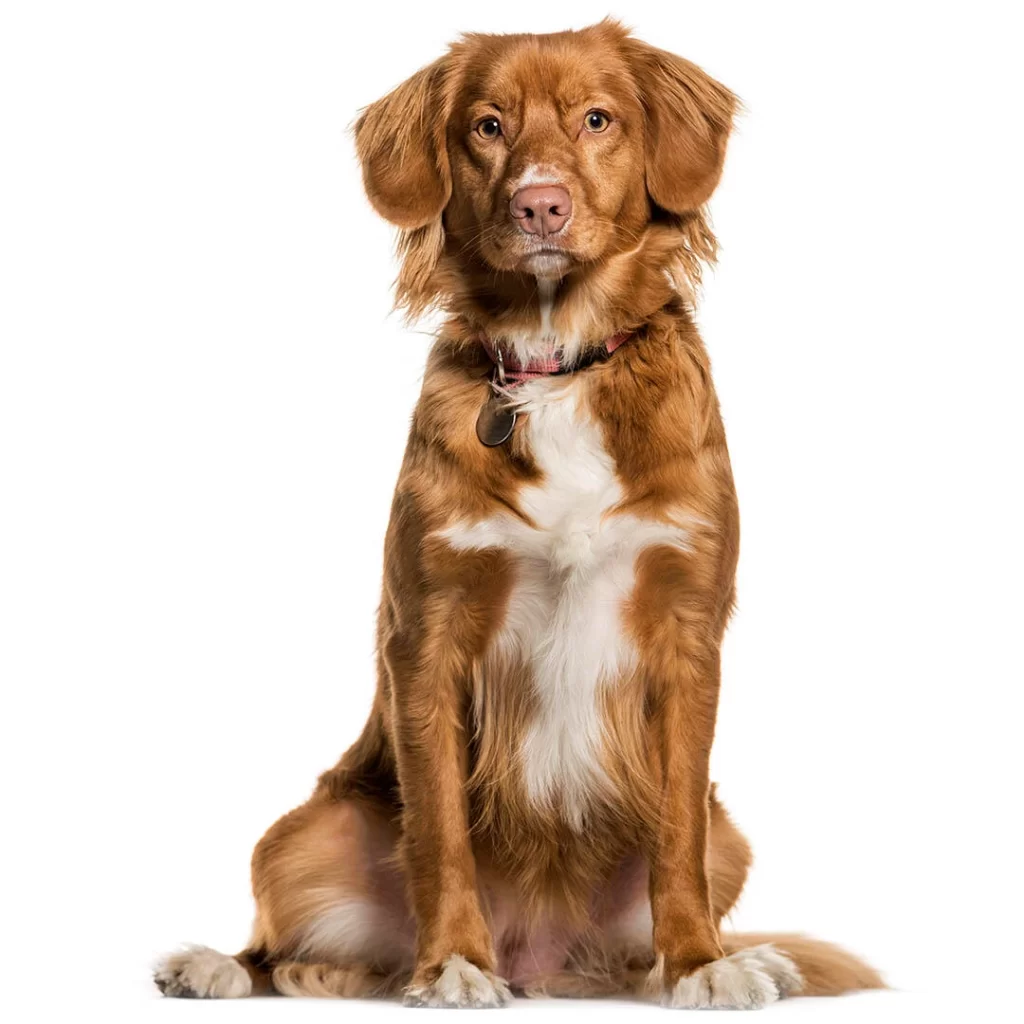
Image Credit – Hemapriya
The Nova Scotia dog, also known as the Nova Scotia Duck Tolling Retriever, is a unique and energetic breed originally from Canada. Loved for its intelligence, agility, and striking reddish coat, this dog was bred to lure and retrieve waterfowl, making it an excellent hunting companion. Beyond its working ability, the Nova Scotia dog is a loyal family pet, known for its affectionate nature and playful personality, which makes it perfect for active households.
Nova Scotia Dog: A Perfect Guide

Originally known as the Little River Duck Dog in its home of the Little River District of Nova Scotia, the modern Toller got its present name in 1945 when it was admitted to the CKC registry. As usual, the exact origin of the breed is lost, but a dog resembling the present-day Toller was seen in 17th Century Europe, luring waterfowl into nets. Whether the Toller originated from these dogs or was developed from a combination of the extinct Lesser St. John’s Water Dog, brown Cocker Spaniels, and Irish Setters with a smattering of Golden Retriever, farm collie, and Chesapeake Bay Retrievers is a matter for speculation.
Whatever the mixture, the result is a 40-50 pound dog of red color and medium-length coat with the peculiar ability to entice ducks and geese close to shore.
Tolling
To “toll” in duck hunting parlance is to entice or lure, a rather archaic definition of the word most associate with road and bridge fees and ringing bells.
Waterfowl hunters generally wait from a concealed spot for ducks or geese to come close enough for a shot. Hunters fortunate enough to have a Toller along can hasten the process by using the dog’s playful antics to catch the attention of inquisitive birds. The hunter tosses a tolling stick from his hiding place towards the shore. The dog goes after the stick with great enthusiasm, tail wagging and feet dancing. The flashy white markings on his chest, feet, and tail-tip accentuate the effect as he retrieves the stick time after time, enticing the birds closer and closer to shore to get a better look at this remarkable performance.
When the birds are close enough for a clean shot, the hunter calls the dog back to his side until there are birds to bring in, and the Toller momentarily shucks his playful persona to become a strong and able retriever.
Breed standard
Intelligent, easy to train, and with great endurance, the Toller is a strong and able swimmer and a natural and tenacious retriever on land and water. Agile and alert, he is happiest while working.
The breed standard describes the Toller as “a medium-sized, powerful, compact, balanced, well-muscled dog, medium to heavy in bone, with a high degree of agility, alertness, and determination. At work, the dog has a speedy, rushing action with the head carried out almost level with the back and the heavily-feathered tail in constant motion.”
There’s a moderate range in size for this smallest retriever: the ideal height for adult males is 19 inches but 18-21 inches is acceptable. The ideal height for females is 18 inches with a range of 17-20 inches. Weight for males is 45-51 pounds, for females, 37-43 pounds.
The Toller has a medium-length double coat with a water-repellant overcoat and a soft, dense undercoat. There can be a slight wave on the back, but otherwise, the coat must be straight. The body has some feathering at the throat, behind the ears, at the back of the thighs and the front legs. The tail is heavily feathered.
The standard accepts only shades of red with limited white markings on the tail tip, chest, face, and feet. White is not allowed on other parts of the body. Some Tollers have no white markings.
The Toller head is slightly wedge-shaped, the skull slightly rounded, and the muzzle slightly tapered. The ears are triangular, medium-sized, and only slightly erect at the base; the rest of the ear leather folds over.
Feet must be webbed.
All in all, first impression of a Toller is that of a Golden Retriever-Border Collie cross combining the coat color and happy-go-lucky Golden temperament with the Border Collie size, muzzle, and drive. But owners may quickly correct that impression with a chuckle and some details about this unique breed.
Health
Breeders are working hard to keep genetic problems to a minimum. Like other retrievers, Tollers are susceptible to hip dysplasia and eye problems, so all breeding stock should have hips x-rayed and eyes tested according to recommended procedures. Both progressive retinal atrophy and juvenile cataracts are known in the breed, so eye tests are critical. PRA strikes late in life, so annual testing is recommended even after a dog is retired from breeding.
Breeders are jealous of their dogs and are working to prevent genetic problems. The Nova Scotia Duck Tolling Retriever Club of America is taking the initiative with projects to help breeders identify dogs that have or are genetically predisposed to harmful inherited conditions.
The Toller as pet
Tollers are gentle with children but may be aloof with strange adults, a trait that makes them reliable as watchdogs (but not guard dogs).
Size, disposition, and easy care make the Toller a fine pet for an active family as well as an able helpmate for a hunter. Tollers need daily exercise and love long periods of playing fetch or Frisbee®. They excel at obedience and agility because they like to work. Young dogs may be easily distracted and bored by repetitious training methods, so owners should keep it light and fun. They have a highly developed hunting instinct honed by years of dedicated breeding practices, so training methods that recognize this instinct are likely to be more successful.
Grooming is simple: run a brush through the coat a couple of times a week to get rid of debris picked up in the woods and fields and to prevent tangles in the feathering.
AKC recognition
After a long and arduous journey that began in 1998, the American Kennel Club finally recognized the Toller for registration in 2003. The 150th dog breed in the registry, the Toller joins the Labrador, Golden, Flat-coated, and Curly-coated retrievers in the sporting group. As a result, Tollers are now eligible to compete in AKC conformation, obedience, agility, tracking, and field events, so watch for them at local shows.
However, there’s no doubt that the Toller is still a rare breed. NSDTRCA has about 400 dogs in its registry, and because breeders are more interested in maintaining breed quality than in selling puppies, the waiting line for a puppy may be long. Breeders tend to be picky about selling their pups as well, so prospective buyers should be prepared for an inquisition.
In conclusion, the Nova Scotia dog is not only a skilled hunting retriever but also a loving and energetic companion. With its sharp mind, lively spirit, and strong bond with humans, it continues to win the hearts of dog lovers worldwide. If you are looking for a devoted pet that thrives on activity and companionship, the Nova Scotia dog could be the perfect choice. Let us know in the comments what you love most about the Nova Scotia dog!
Frequently Asked Questions
What makes the Nova Scotia dog unique compared to other retrievers?
The Nova Scotia dog stands out for its “tolling” ability, where it lures waterfowl within range for hunters. Its smaller size, intelligence, and striking red coat also make it unique.
Is the Nova Scotia dog good for families?
Yes, the Nova Scotia dog is an affectionate and playful breed that gets along well with children and active families, provided it gets enough exercise and mental stimulation.
How much exercise does a Nova Scotia dog need daily?
A Nova Scotia dog requires at least 1–2 hours of exercise daily, including walks, playtime, and training, to stay happy and healthy.






